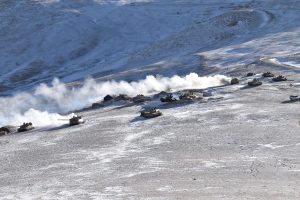Sudha Ramachandran

In this photograph provided by the Indian Army, tanks pull back from the banks of Pangong Tso lake region, in Ladakh along the India-China border on Wednesday, Feb. 10, 2021.Credit: Indian Army via AP
India’s situation along its disputed border with China in Ladakh appears to be far more serious than the government is letting on.
A police officer from Leh in Ladakh recently disclosed that India has lost access to 26 of 65 patrolling points from the Karakoram Pass to Chumar along the Line of Actual Control (LAC) in Ladakh.
In her research paper submitted at the 57th annual conference of India’s top police officials in New Delhi on January 20-22, Leh’s Senior Superintendent of Police P.D. Nithya said that “due to restrictive or no patrolling” by Indian forces at several patrolling points, India had lost access to patrolling points 5-17, 24-32, 37, 51, 52 and 62.
The absence of Indian troops at these patrolling points opened up space for Chinese soldiers to move in, the paper notes, forcing India to accept that these areas now have a Chinese presence. This has led to a shift in the LAC “towards the Indian side.”
Since April-May 2020, when PLA soldiers backed by tanks and armored personnel carriers crossed into areas that were previously patrolled by the Indian Army, the situation along the LAC has been tense.
The research paper argues that Indian apprehensions over drawing Chinese ire, even objections to Indian presence in territory deemed disputed by Beijing has resulted in India adopting a “play safe” strategy that has resulted in India pulling back from territory it controlled previously.
This is contrary to what Indian political and military leaders have been saying over the past 2.5 years.
On June 19, 2020, four days after Indian and Chinese soldiers clashed at Galwan Valley, Prime Minister Narendra Modi denied outright that Chinese soldiers had crossed into the Indian side of the LAC. “Neither has anyone intruded into Indian territory nor has anyone captured any military posts,” he stated emphatically. Ministers and military officials have since echoed him and claimed that India has “not lost even one inch of territory” in recent years.
Besides, the Modi government has often sought to project a tough, uncompromising stance towards the Chinese on the border question. Defense Minister Rajnath Singh has often said that India would give a “fitting reply” if “even an inch of our land” was taken.
However, the reality on the ground along the LAC has been quite different, as per the research paper.
Not only has the Indian Army been pulling back from areas it traditionally patrolled but also it has played safe by placing “much restrictions on the movement of civilians and grazers near the forward areas on the Indian side” to avoid annoying the Chinese or giving them “the chance to raise objections” to Indian activity or presence in “areas claimed as disputed,” the paper notes.
Far from giving a “fitting reply” to the PLA’s advance into Indian-controlled territory, India’s response has been timid.
“The government’s official narrative stands exposed,” points out Lt Gen (retd.) Prakash Katoch.
The paper recalls that senior civilian officials of the district administration as well as the security forces used to “easily patrol” up to the Karakoram Pass, which is 35 km from India’s northernmost post at Daulat Beg Oldie (DBO). However, this changed in December 2021, when the Indian Army set up “restrictions in the form of check posts” at DBO “to stop any such movement towards Karakoram Pass,” as the PLA would object to any “movement [towards Karakoram] from the Indian side if not informed beforehand.” These areas then became “informal buffer zone,” to which India has lost access.
The territorial gains that the PLA made on the ground through its salami slicing strategy were taken forward by its military commanders at negotiations with their Indian counterparts. The talks led to disengagement of troops from some friction points it has come at a heavy cost as India had to agree to buffer zones. These buffer zones were created as per the new changed situation on the ground rather than the pre-April 2020 ground situation. Consequently, the no-patrolling areas have come up largely on territory on the Indian side.
Much of what the research paper says has been said before.
A December 2020 report in The Hindu said that at least 30 patrolling points in Ladakh were not being patrolled any more by Indian soldiers. A section of former army officers and security analysts have been drawing attention to India’s territorial losses in the Himalayas. They have pointed out that disengagement from four friction areas “have been disadvantageous to India” as buffer zones have come up either “entirely on territory both claimed and previously patrolled by India but now, as a result, India is denied the right to patrol up to where it previously could.”
The paper affirms what experts have been saying for 2.5 years – India is losing territory to the Chinese.
That a police officer based in Ladakh has confirm these apprehensions is significant.
The question is whether Nithya’s paper and the storm it has kicked up will nudge the Modi government to take parliament into confidence on the matter. Or will obfuscation and denial continue to be the government’s response?
Soon after the research paper was published in several Indian newspapers, India’s Ministry of Home Affairs took down the paper from its website.
That is a pointer to the government’s strategy going ahead.
No comments:
Post a Comment